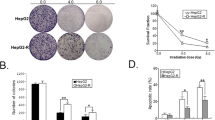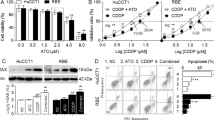Abstract
Resistance of cholangiocarcinoma to irradiation therapy is a major problem in cancer treatment. Slug, a snail family transcription factor, is a suppressor of PUMA (p53 upregulated modulator of apoptosis), which has been shown to be involved in the control of apoptosis. In this study, we investigated whether the modulation of Slug expression, using adeno-associated-virus-mediated transfer of siRNA targeting Slug gene (rAAV2-Slug siRNA), affects cholangiocarcinoma sensitivity to radiation. In the present study, we used rAAV2-Slug siRNA to downregulate the expression of Slug in QBC939 cholangiocarcinoma cell lines in vitro before γ-irradiation. In vivo studies were done with orthotopic cholangiocarcinoma, and radiosensitivity was evaluated both in vitro and in vivo. rAAV2-Slug siRNA transfection resulted in downregulation of the levels of Slug in QBC939 cells. In addition, rAAV2-Slug siRNA, in combination with radiation, increased levels of the PUMA, which contributes to the radiosensitivity of cholangiocarcinomas. Finally, treatment with rAAV2-Slug siRNA plus γ-irradiation completely regressed tumor growth in orthotopic cholangiocarcinomas model. In summary, integrating gene therapy with radiotherapy could have a synergistic effect, thereby improving the survival of patients with cholangiocarcinomas.





Similar content being viewed by others
References
de Groen PC, Gores GJ, LaRusso NF, Gunderson LL, Nagorney DM. Biliary tract cancers. N Engl J Med. 1999;341:1368–78.
Lazaridis KN, Gores GJ. Cholangiocarcinoma. Gastroenterology. 2005;128:1655–67.
Nair S, Shiv Kumar K, Thuluvath PJ. Mortality from hepatocellular and biliary cancers: changing epidemiological trends. Am J Gastroenterol. 2002;97:167–71.
Patel T. Increasing incidence and mortality of primary intrahepatic cholangio-carcinoma in the United States. Hepatology. 2001;33:1353–7.
Olnes MJ, Erlich R. A review and update on cholangiocarcinoma. Oncology. 2004;66:167–79.
Jarnagin WR, Fong Y, DeMatteo RP, et al. Staging, resectability, and outcome in 225 patients with hilar cholangiocarcinoma. Ann Surg. 2001;234:507–17. discussion 517–519.
Witzigmann H, Berr F, Ringel U, et al. Surgical and palliative management and outcome in 184 patients with hilar cholangiocarcinoma: palliative photodynamic therapy plus stenting is comparable to r1/r2 resection. Ann Surg. 2006;244:230–9.
Sasaki A, Aramaki M, Kawano K, et al. Intrahepatic peripheral cholangiocarcinoma: mode of spread and choice of surgical treatment. Br J Surg. 1998;85:1206–9.
Nakeeb A, Pitt HA, Sohn TA, et al. Cholangiocarcinoma: a spectrum of intrahepatic, perihilar, and distal tumors. Ann Surg. 1996;224:463–73. discussion 473–475.
Washburn WK, Lewis WD, Jenkins RL. Aggressive surgical resection for cholangiocarcinoma. Arch Surg. 1995;130:270–6.
Patel T, Singh P. Cholangiocarcinoma: emerging approaches to a challenging cancer. Curr Opin Gastroenterol. 2007;23:317–23.
Reddy SB, Patel T. Current approaches to the diagnosis and treatment of cholangiocarcinoma. Curr Gastroenterol Rep. 2006;8:30–7.
Mansfield SD, Barakat O, Charnley RM, et al. Management of hilar cholangiocarcinoma in the North of England: pathology, treatment, and outcome. World J Gastroenterol. 2005;11:7625–30.
Wiedmann MW, Mössner J. Molecular targeted therapy of biliary tract cancer–results of the first clinical studies. Curr Drug Targets. 2010;11:834–50.
Briggs CD, Neal CP, Mann CD, Steward WP, Manson MM, Berry DP. Prognostic molecular markers in cholangiocarcinoma: a systematic review. Eur J Cancer. 2009;45:33–47.
Coultas L, Strasser A. The molecular control of DNA damage-induced cell death. Apoptosis. 2000;5:491–507.
He GJ, Sun DD, Ji DW, Sui DM, Yu FQ, Gao QY, Dai XW, Gao H, Jiang T, Dai CL. Induction of biliary cholangiocarcinoma cell apoptosis by 103Pd cholangial radioactive stent gamma-rays. Chin Med J (Engl). 2008;121:1020–4.
Yabuuchi S, Katayose Y, Oda A, Mizuma M, Shirasou S, Sasaki T, Yamamoto K, Oikawa M, Rikiyama T, Onogawa T, Yoshida H, Ohtuska H, Motoi F, Egawa S, Unno M. ZD1839 (IRESSA) stabilizes p27Kip1 and enhances radiosensitivity in cholangiocarcinoma cell lines. Anticancer Res. 2009;29:1169–80.
Bianco C, Tortora G, Bianco R, Caputo R, Veneziani BM, Caputo R, Damiano V, Troiani T, Fontanini G, Raben D, Pepe S, Bianco AR, Ciardiello F. Enhancement of antitumor activity of ionizing radiation by combined treatment with the selective epidermal growth factor receptor-tyrosine kinase inhibitor ZD1839 (Iressa). Clin Cancer Res. 2002;8:3250–8.
Nieto MA. The Snail superfamily of zinc finger transcription factors. Nat Rev Mol Cell Biol. 2002;3:155–66.
Ros MA, Sefton M, Nieto MA. Slug, a zinc-finger gene previously implicated in the early patterning of the mesodermand the neural crest, is also involved in chick limb development. Development. 1997;124:1821–9.
Savagner P, Yamada KM, Thiery JP. The zinc-finger protein Slug causes desmosome dissociation, an initial and necessary step for growth factor-induced epithelial-mesenchymal transition. J Cell Biol. 1997;137:1403–19.
Gupta PB, Kuperwasser C, Brunet JP, Ramaswamy S, Kuo WL, Gray JW, Naber SP, Weinberg RA. The melanocyte differentiation program predisposes to metastasis after neoplastic transformation. Nat Genet. 2005;37:1047–54.
Kurrey NK, Bapat SA. Snail and Slug are major determinants of ovarian cancer invasiveness at the transcription level. Gynecol Oncol. 2005;97:155–65.
Martin TA, Goyal A, Watkins G, Jiang WG. Expression of the transcription factors snail, slug, and twist and their clinical significance in human breast cancer. Ann Surg Oncol. 2005;12:488–96.
Perez-Mancera PA, Gonzalez-Herrero I, Perez-Caro M, Gutierrez-Cianca N, Flores T, Gutierrez-Adan A, Pintado B, Sanchez-Martin M, Sanchez-Garcia I. SLUG in cancer development. Oncogene. 2005;24:3073–82.
Zhang K, Wang D, Zhang S, Jiao X, Li C, Wang X, Yu Q, Cui H. The E-cadherin repressor slug and progression of human hilar cholangiocarcinoma. J Exp Clin Cancer Res. 2010;1(29):88.
Zhang KJ, Zhang BY, Zhang KP, Tang LM, Liu SS, Zhu DM, Zhang DL. Clinicopathologic significance of slug expression in human intrahepatic cholangiocarcinoma. World J Gastroenterol. 2010;16:2554–7.
Hemavathy K, Ashraf SI, Ip YT. Snail/slug family of repressors: slowly going into the fast lane of development and cancer. Gene. 2000;257:1–12.
Inukai T, Inoue A, Kurosawa H, et al. SLUG, a ces-1-related zinc finger transcription factor gene with antiapoptotic activity, is a downstream target of the E2A-HLF oncoprotein. Mol Cell. 1999;4:343–52.
Kajita M, McClinic KN, Wade PA. Aberrant expression of the transcription factors snail and slug alters the response to genotoxic stress. Mol Cell Biol. 2004;24:7559–66.
Kajita M, McClinic KN, Wade PA. Aberrant expression of the transcription factors snail and slug alters the response to genotoxic stress. Mol Cell Biol. 2004;24:7559–66.
Kurrey NK, Jalgaonkar SP, Joglekar AV, Ghanate AD, Chaskar PD, Doiphode RY, Bapat SA. Snail and slug mediate radioresistance and chemoresistance by antagonizing p53-mediated apoptosis and acquiring a stem-like phenotype in ovarian cancer cells. Stem Cells. 2009;27:2059–68.
Cano A, Perez-Moreno MA, Rodrigo I, et al. The transcription factor snail controls epithelial-mesenchymal transitions by repressing E-cadherin expression. Nat Cell Biol. 2000;2:76–83.
Guaita S, Puig I, Franci C, et al. Snail induction of epithelial to mesenchymal transition in tumor cells is accompanied by MUC1 repression and ZEB1 expression. J Biol Chem. 2002;277:39209–16.
Cha HS, Bae EK, Ahn JK, Lee J, Ahn KS, Koh EM. Slug suppression induces apoptosis via Puma transactivation in rheumatoid arthritis fibroblast-like synoviocytes treated with hydrogen peroxide. Exp Mol Med. 2010;42:428–36.
Wu WS, Heinrichs S, Xu D, Garrison SP, Zambetti GP, Adams JM, Look AT. Slug antagonizes p53-mediated apoptosis of hematopoietic progenitors by repressing puma. Cell. 2005;123:641–53.
Yu J, Zhang L. No PUMA no death: implications for p53-dependent apoptosis. Cancer Cell. 2003;4:248–9.
Yu J, Zhang L, Hwang PM, Kinzler KW, Vogelstein B. PUMA induces the rapid apoptosis of colorectal cancer cells. Mol Cell. 2001;7:673–82.
Nakano K, Vousden KH. PUMA, anovel proapoptotic gene, is induced by p53. Mol Cell. 2001;7:683–94.
Han J, Flemington C, Houghton AB. Expression of bbc3, a pro-apoptotic BH3-only gene, is regulated by diverse cell death and survival signals. Proc Natl Acad Sci U S A. 2001;98:11318–23.
Yu J, Wang Z, Kinzler KW, Vogelstein B, Zhang L. PUMA mediates the apoptotic response to p53 in colorectal cancer cells. Proc Natl Acad Sci U S A. 2003;100:1931–6.
Villunger A, Michalak EM, Coultas L. p 53- and drug-induced apoptotic responses mediated by BH3-only proteins Puma and Noxa. Science. 2003;302:1036–8.
Jeffers JR, Parganas E, Lee Y. Puma is an essential mediator of p53-dependent and -independent apoptotic pathways. Cancer Cell. 2003;4:321–8.
Coureuil M, Ugolin N, Tavernier M, Chevillard S, Barroca V, Fouchet P, Allemand I. Puma and trail/dr5 pathways control radiation-induced apoptosis in distinct populations of testicular progenitors. PLoS One. 2010;5:e12134.
Erlacher M, Michalak EM, Kelly PN, Labi V, Niederegger H, Coultas L, Adams JM, Strasser A, Villunger A. BH3-only proteins Puma and Bim are rate-limiting for gamma-radiation- and glucocorticoid-induced apoptosis of lymphoid cells in vivo. Blood. 2005;106:4131–8.
Yu H, Shen H, Yuan Y, XuFeng R, Hu X, Garrison SP, Zhang L, Yu J, Zambetti GP, Cheng T. Deletion of Puma protects hematopoietic stem cells and confers long-term survival in response to high-dose gamma-irradiation. Blood. 2010;115:3472–80.
Qiu W, Carson-Walter EB, Liu H, Epperly M, Greenberger JS, Zambetti GP, Zhang L, Yu J. PUMA regulates intestinal progenitor cell radiosensitivity and gastrointestinal syndrome. Cell Stem Cell. 2008;2:576–83.
Maier P, Herskind C, Zeller WJ, Wenz F. SLUG as a novel radioprotector of normal tissue by gene transfer using a lentiviral bicistronic SIN vector. Radiat Oncol. 2009;3:8174–5.
Yang H, Wan H, Yu J, Zhang X, Zhang L, Fu M, Liang X, Zhan Q, Lin C. Administration of PUMA adenovirus increases the sensitivity of esophageal cancer cells to anticancer drugs. Cancer Biol Ther. 2006;5:380–5.
Yu J, Yue W, Wu B, Zhang L. PUMA sensitizes lung cancer cells to chemotherapeutic agents and irradiation. Clin Cancer Res. 2006;12:2928–36.
Bacqueville D, Deleris P, Mendre C, et al. Characterization of a G protein-activated phosphoinositide 3-kinase in vascular smooth muscle cell nuclei. J Biol Chem. 2001;276:22170–6.
Zhang K, Zhang S, Jiao X, Wang H, Zhang D, Niu Z, Shen Y, Lv L, Zhou Y. Slug regulates proliferation and invasiveness of esophageal adenocarcinoma cells in vitro and vivo. Med Oncol. 2010.
Haupt S, Alsheich-Bartok O, Haupt Y. Clues from worms: a Slug at Puma promotes the survival of blood progenitors. Cell Death Differ. 2006;13:913–5.
Vannini I, Bonafe M, Tesei A, Rosetti M, Fabbri F, Storci G, Ulivi P, Brigliadori G, Amadori D, Zoli W. Short interfering RNA directed against the SLUG gene increases cell death induction in human melanoma cell lines exposed to cisplatin and fotemustine. Cell Oncol. 2007;29:279–87.
Yu J, Zhang L. PUMA, a potent killer with or without p53. Oncogene. 2008;27(Suppl 1):S71–83.
Michalak EM, Vandenberg CJ, Delbridge AR, Wu L, Scott CL, Adams JM, Strasser A. Apoptosis-promoted tumorigenesis: gamma-irradiation-induced thymic lymphomagenesis requires Puma-driven leukocyte death. Genes Dev. 2010;24:1608–13.
Acknowledgments
We take this opportunity to specifically thank the reviewers and editors for their kind instructions that may be helpful for our further studies.
Conflict of interest
The authors promised there were not any possible conflicts of interest in this research.
Author information
Authors and Affiliations
Corresponding author
Additional information
Kejun Zhang and Bingyuan Zhang contributed equally to this work.
Rights and permissions
About this article
Cite this article
Zhang, K., Zhang, B., Lu, Y. et al. Slug inhibition upregulates radiation-induced PUMA activity leading to apoptosis in cholangiocarcinomas. Med Oncol 28 (Suppl 1), 301–309 (2011). https://doi.org/10.1007/s12032-010-9759-x
Received:
Accepted:
Published:
Issue Date:
DOI: https://doi.org/10.1007/s12032-010-9759-x




